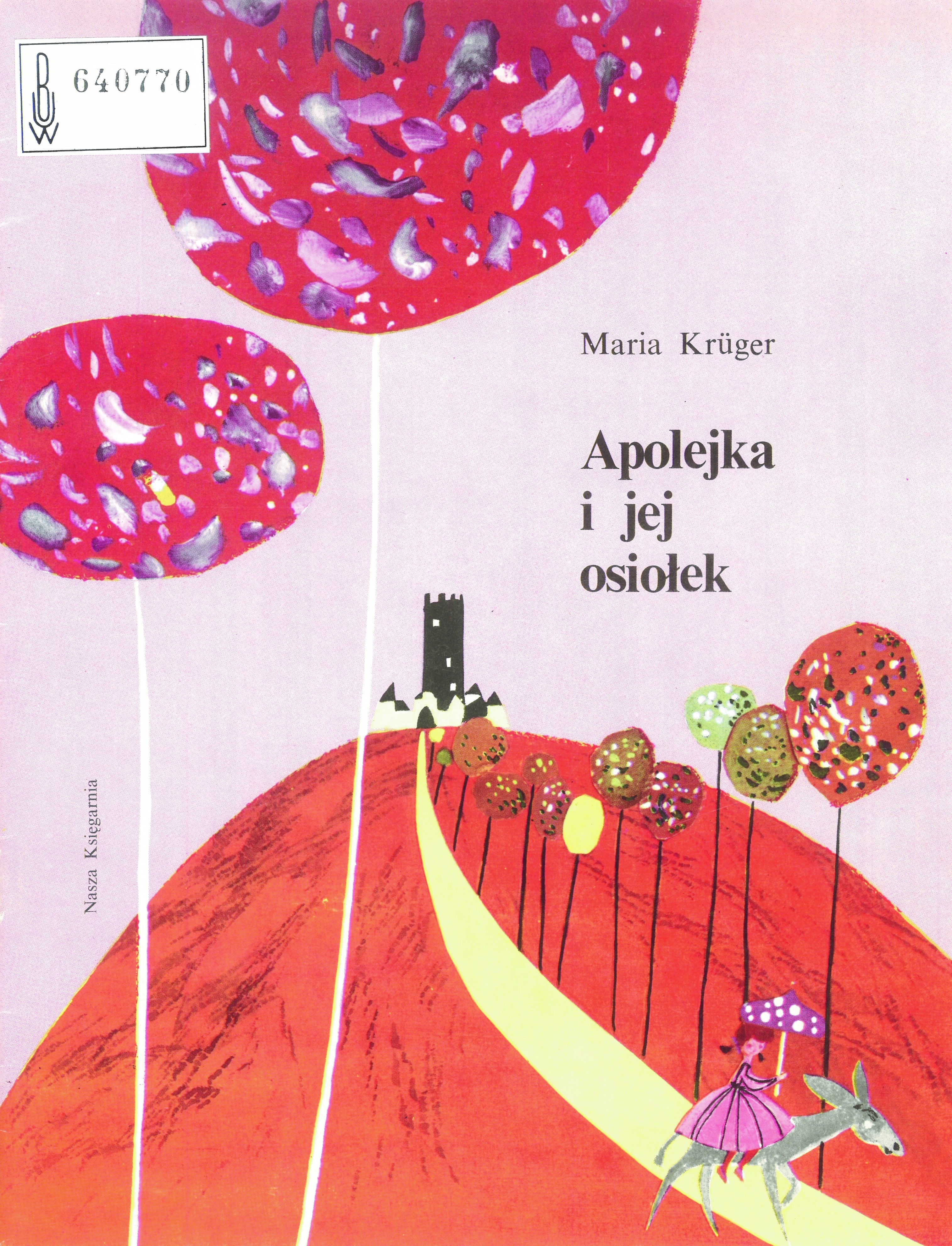Title of the work
Country of the First Edition
Country/countries of popularity
Original Language
First Edition Date
First Edition Details
Maria Krüger, Apolejka i jej osiołek, ill. Zdzisław Witwicki. Warszawa: Nasza Księgarnia, 1963, 28 pp.
ISBN
Genre
Fairy tales
Target Audience
Children
Cover

Cover from the edition Warsaw: Nasza Ksiegarnia, 1991. Cover design and illustrations by Zdzisław Witwicki.
Author of the Entry:
Summary: Gabriela Rogowska, University of Warsaw, g.rogowska@al.uw.edu.pl
Analysis: Marta Pszczolińska, University of Warsaw, m.pszczolinska@al.uw.edu.pl
Peer-reviewer of the Entry:
Katarzyna Marciniak, University of Warsaw, kamar@al.uw.edu.pl
Elżbieta Olechowska, University of Warsaw, elzbieta.olechowska@gmail.com

Photograph retrieved from Encyklopedia Fantastyki (accessed: December 28, 2020).
Maria Krüger
, 1904 - 1999
(Author)
A writer, journalist, economist. Graduated from the Faculty of the Humanities at the University of Warsaw; alumna of the Academy of Political Science in Warsaw. During WW2, she participated in the Warsaw Uprising (1944). She began publishing for children and teenagers in children’s periodicals such as “Płomyczek,” “Dziatwa,” “Słonko,” “Świerszczyk,” “Płomyk.” She proposed the idea and wrote texts for the television show Miś z okienka [Teddy Bear at the Window]. Her books have been translated into foreign languages and adapted for films. She is best known for her novel Karolcia [Charlotte], 1959.
Sources:
"Maria Krüger", in Elżbieta Zarych, ed., Słownik pisarzy polskich, Kraków: Krakowskie Wydawnictwo Naukowe, 2008, 253.
"Maria Krüger", in Jadwiga Czachowska and Alicja Szałagan, eds., Współcześni polscy pisarze i badacze literatury. Słownik biobibliograficzny, vol. 4: K, Warszawa: Wydawnictwa Szkolne i Pedagogiczne, 1996, 387–389.
"Maria Krüger", in Lesław M. Bartelski, Polscy pisarze współcześni 1939–1991. Leksykon, Warszawa: Wydawnictwo Naukowe PWN, 1995, 207.
Maria Krüger, wikipedia.org (accessed: December 28, 2020).
Maria Krüger, encyklopediafantastyki.pl (accessed: December 28, 2020).
Bio prepared by Gabriela Rogowska, University of Warsaw, g.rogowska@al.uw.edu.pl
Translation
Czech: Apolenka a její oslíček, trans. Oldřich Syrovátka, Praha: Státni naklad. dêtské knihy, 1967.
Dutch: Prinses Apoleika en haar ezeltje, trans. Inge Groeneveld, Amersfoort: A. Roelofs van Goor, 1967.
Finnish: Apoleika ja hänen aasinsa, trans. Veli Kolari, Helsinki: Otava, 1966.
German: Die Prinzessin und ihr Eselchen, trans. Hellmuth Burkhardt, Niederwiesa: Karl Nitzsche, 1965.
Summary
Based on: Katarzyna Marciniak, Elżbieta Olechowska, Joanna Kłos, Michał Kucharski (eds.), Polish Literature for Children & Young Adults Inspired by Classical Antiquity: A Catalogue, Faculty of “Artes Liberales”, Warsaw: University of Warsaw, 2013, 444 pp.
A princess named Apolejka lives alone in a high tower on a hill outside the town. One day from the windows of her tower she notices a chimney-sweep drinking water from the well. The very next instant the boy turns into a donkey; after eating an apple from a magic tree, he returns to his human form.
The chimney-sweep goes away but soon comes a prince singing a song for Apolejka. But, by the time the girl runs downstairs to welcome the prince, he has already drunk the water from the bewitched well and has become a donkey.
Apolejka wants to break the spell by making him eat the magic apple but the only one left is rolling down the hill and falls into a heap of apples on a town market stall. There is no other way to find the magic apple than to taste them all. In exchange for the fruit Apolejka has to give away her umbrella, beads, ring, hair ribbons and even shoes. The magic apple is the last one tasted and because there is a bite missing — the prince does not transform entirely — his head remains still a donkey’s head. Apolejka kisses him and her kiss makes him human again.
Analysis
Apolejka and Her Donkey was prepared as a part of an editorial series Moje książeczki, published by Nasza Księgarnia publishing house from the 1950s till the late 1980s. The series has a characteristic logo, recognizable by every child these days: a black cat with big green eyes and red boots designed by Zbigniew Rychlicki (1922–1989), co-creator of a popular animated television series for children about a teddy bear called Miś Uszatek [Teddy Floppy-Ears]. Apolejka is a strong evergreen of the series, and the last reprint was published in 2016 as a part of the collective works of Moje książeczki, preserving the original format and brilliant illustrations by Zdzisław Witwicki (1921–2019), another well-known artist, as an integral part of all editions.
The fairy tale, written in a language well-adjusted to the youngest readers, combines elements of magical narration in fairy tales for children and some elements of antiquity, although both are not recognizable for children absorbed in the adventure of a child princess.
The story is simple, but full of details making the main character easy to identify with and sympathize. The little princess wears two thin pigtails decorated with blue ribbons, her crown is always tilting towards her left ear, and she lives alone in a high tower with no one to talk to or play with. Even going out to play in the garden is a problem because the tower has steep winding stairs (176 steps) – hence, potentially dangerous for a child – and the girl prefers to look through the window. When the singing prince appears, she hopes that she will have a chance not to feel lonely any more, and so her adventure begins. Apolejka is full of compassion about what happened to the prince, magically turned into a donkey, but “wait and see” is not an option any more. She actively takes matters into her hands and finds a solution, even if it means a sacrifice. The intriguing character, created by Krüger, makes the little reader think and ask questions. The unfortunate prince, however, inspires sympathy – the little donkey first carries Apolejka on his back to catch the rolling apple, then he must eat a huge pile of apples despite being full – apples lose their appeal fast – a situation well known to all fussy eaters. Finally, he cries, when people laugh at him and mock him because his head remains asinine while the rest of his body became human again. The child reader realizes that unpleasant situations well known from everyday life can happen even to a prince – like being forced to eat or being ridiculed.
References to Classical Antiquity are first hinted at in the title: both the name of the main character and the donkey evoke the Latin prose writer Apuleius Madaurensis and his most famous novel, Metamorphoses or The Golden Ass probably based on the lost Greek novel Lucius, or the Ass attributed to Lucian of Samosata. In the novel, Maria Krüger uses Apuleius’ motif of the transformation of a boy into a donkey and back to a boy, exactly like it happened to the Apuleian Lucius. In the Roman model, the transformation happens by accident and possibly through the use of magic, here, replaced by magical water from an enchanted well. Apuleius uses a combination of an ointment and a spell to transform the man into an animal. In both tales, the metamorphosis is reversible – to return to human form, the donkey has to eat a specific plant. Apuleius’ rose becomes Krüger’s magical apple. Another allusion to Antiquity is the image of a man with an animal head which brings to mind the myth of the Minotaur, a human-animal hybrid.


